#rare earth elements
Text
jumping right to the very best from the glaze firing disaster that made a mess of my kiln;

there are no words to express my undying love of REE's in crystalline glazes. and this first attempt using a new element truly made up for putting my livelihood on hold, fucking up my kiln AND getting covid during my 35th birthday and thanksgiving...
let's investigate with some close-ups;


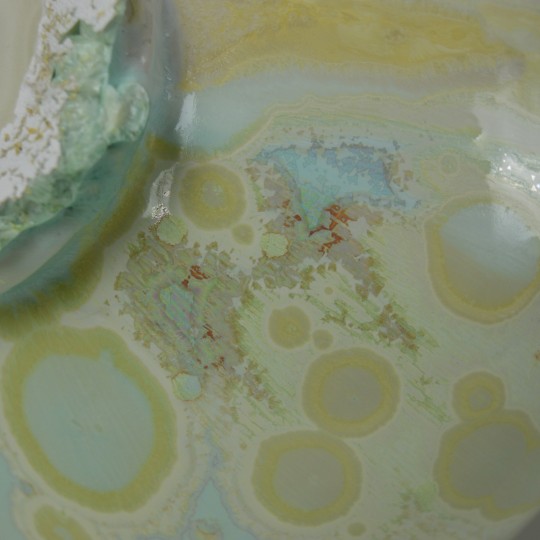
*bites lip seductively*
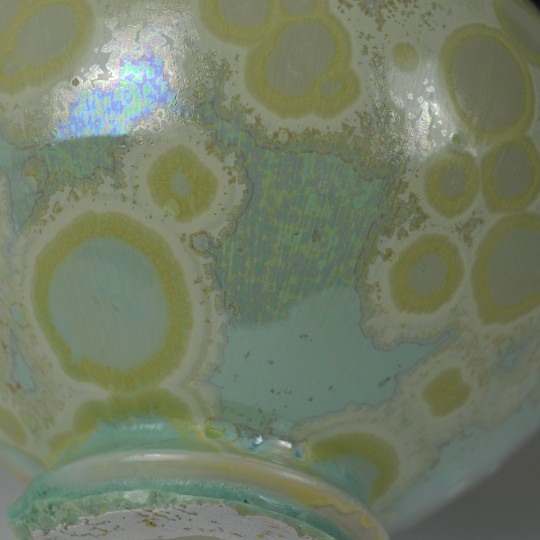
iridescent triangular crystals? say it ain't so...



*drops to floor twerking in appreciation*
officially naming this glaze test
Unicorn Cum
i am in love.
#pottery#ceramics#clay#wheelthrownpottery#porcelain#full time artist#glaze testing#crystal growing#chemistry#artists on tumblr#iglazeperiodically#triangle#alt j#change#crystalporn#unicorn#iridescent#rare earth elements#rainbow#colorful
56 notes
·
View notes
Text
Cornell University scientists have characterized the genome of a metal-loving bacteria with an affinity for rare earth elements. The research paves the way towards replacing the harsh chemical processing of these elements with a benign practice called biosorption.
Rare earth elements power electric cars, wind turbines and smartphones. Today, retrieving these metals from raw ore requires processing with acids and solvents. But a new technology, envisioned by the scientists and powered by a microbe, could make processing rare earth elements cleaner and scalable -- helping provide a steady U.S. supply for clean energy infrastructure and defense applications.
Their research, "Genomic characterization of rare earth binding by Shewanella oneidensis," was published in Scientific Reports.
"The problem with the current methods of rare earth element purification is that they rely heavily on organic solvents and harsh chemicals," said senior author Buz Barstow, assistant professor of biological and environmental engineering. "These methods are costly and environmentally damaging. Here we have a green alternative that uses microbes to selectively adsorb and purify rare earth elements, eliminating the need for harmful chemicals. We're making the purification process greener."
Read more.
42 notes
·
View notes
Text

Terres, 2023
Dessin, graphite sur canson
@ADGAP
(Soils, 2023, drawing)
26 notes
·
View notes
Text
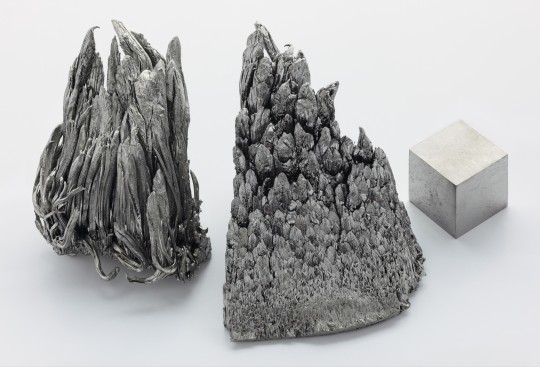
Yttrium samples. (Wikipedia)
#archive#archiving#web archive#yttrium#rare earth elements#chemical elements#metals#rare earth metals#rare earth minerals#chemistry#periodic table of elements#wikipedia
25 notes
·
View notes
Text
Ranked: The Most Expensive Metals on Earth! Click here to find out more ->
#rare earth elements#rare earth minerals#expensive things#most expensive things#interesting facts#illuminating facts#expensive metals
16 notes
·
View notes
Photo

A whispered rumor of vast wealth hidden deep beneath the earth in a Wyoming coal mine had passed from miner to miner, generation to generation. Little did they know that the secret store of wealth contained something far greater and more mysterious - an estimated $37bn worth of rare earth elements, giving the coal miners the power to shape the future in ways they never could have imagined.
2 notes
·
View notes
Text
The Rare Earth - Thorium Link
Chapter 10: The Rare Earth's Thorium Link
How Rare Earths are often discarded as radioactive waste and how the Thorium contained within could provide clean safe and cheap nuclear power
Currently the EPA requires that Thorium (often found in association with rare earth minerals) must be handled in a "...a very specific and costly way...".... causing rare earth mining in the United States to be "prohibitively expensive." .... however, both the environmental and economic problems associated with rare earth mining and processing in the US might be solved ...(by Thorium extraction and utilization) because Thorium can be used in a special type of nuclear reactor which has been shown to be proliferation resistant and safer than the High Pressure Water Reactors which are based on Uranium.
While there are currently no operating Thorium reactors, in the 1960s there was a Thorium fed Liquid Fluoride Salt Reactor at Oakridge National Laboratory that operated without incident for years until it was shut down by Congress in favor of fast breeder reactors.
#rare earth metals#rare earth minerals#rare earth elements#thorium#green energy#nuclear power#technology#mining#nuclear reactor#Chinese competition#national security#neodymium#samarium#Yttrium#Scandium#Cerium
4 notes
·
View notes
Photo

kiruna
#© victor s. brigola#brigola#kiruna#mining#rare earth elements#sweden#norrland#lapland#landscape#new topographics#industry#winter#snow#sky#fuji x-pro 3
4 notes
·
View notes
Text
Recycling Method of Sintered NdFeB Magnet Waste
Recycling Method of Sintered NdFeB Magnet Waste
The waste recycling of NdFeB materials is usually divided into two directions: one is to separate and extract various elements, especially rare earth elements, in the NdFeB waste to prepare oxides or other compounds with a certain purity, which can be used as raw materials for different applications. fields; the second is to use waste materials to…

View On WordPress
#magnet materials#NdFeB magnets#Neodymium iron boron#Neodymium Magnet#Permanent rare earth magnets#rare earth elements#Rare earth Magnet#Rare Earth Magnet Recycling#Rare Earth Recycling#recycle rare earth magnets#recycling magnets#Recycling REEs#REEs
0 notes
Text
Rare Earth Elements in China
Dobrescu, Emilian M. (2023), Rare Earth Elements in China, Intelligence Info, 3:1, xxx,
Abstract
After the volume of deposits, the main concentrates of minerals containing rare earth elements are found in China. Rare earth elements industry began to be developed in China in 1950. The Chinese production gradually started in 1985. Exporting at very low prices, the Chinese eliminate any Western…

View On WordPress
0 notes
Text
China bans exports of rare earth processing technologies
China banned exports of technology to extract and separate critical rare earth metals on Thursday, the country’s latest move to secure its dominance over several strategic materials.
Rare earth elements are a group of 17 metals used to produce magnets capable of converting energy into motion for use in electric cars, wind turbines and electronics. Nathan Picarsic, co-founder of the geopolitical consulting firm Horizon Advisory, stated:
This should be a clarion call that dependence on China in any part of the value chain is not sustainable.
The ban is expected to have the biggest impact on so-called “heavy rare earths,” used in electric motors, medical devices and weapons, where China has a de facto monopoly on refining.
Read more HERE
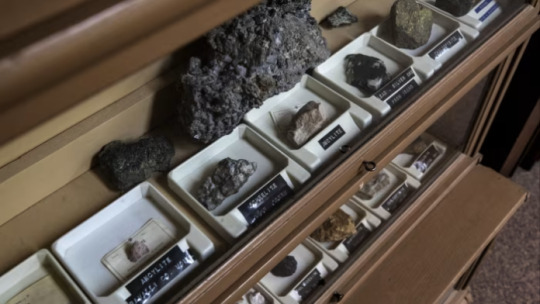
#world news#world politics#news#current events#global news#global politics#political news#china news#china#china politics#chinese politics#rare earth elements#rare earth metals#technology
1 note
·
View note
Text
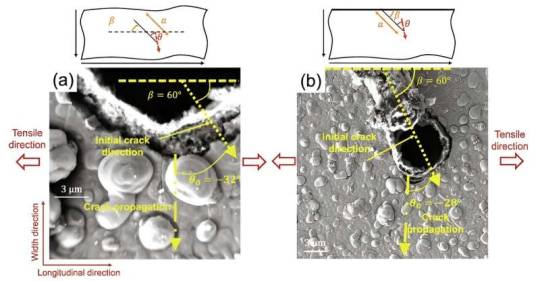
Unraveling the impact of edge cracks on superconducting REBCO tapes: A leap in material durability and efficiency
In the realm of superconductivity, the durability and efficiency of materials like REBCO (Rare Earth Barium Copper Oxide) tapes are crucial for application in various high-tech fields. However, these materials face challenges, particularly when it comes to maintaining their superconducting properties under stress.
A recent study delves into the intricate relationship between mechanical stress and the superconducting capabilities of REBCO tapes, offering new insights that could pave the way for more robust and reliable superconducting materials.
At the heart of this study is examining edge cracks caused by the slitting process in REBCO tapes when subjected to tensile stress. These tapes, known for their high critical current capacity, are essential in many superconducting applications, from medical imaging equipment to particle accelerators. It was widely believed that even minor edge cracks could propagate and cause premature degradation of REBCO tapes when subjected to stress, raising concerns about the longevity and reliability of these materials in practical applications.
Read more.
#Materials Science#Science#Superconductors#Materials failure#Rare earth elements#Cuprates#Stress and strain#Cracking
19 notes
·
View notes
Text

Researchers at Penn State have uncovered a fresh method through which bacteria may choose between several rare earth elements. When a bacterial protein is attached to some rare earths, it has the capacity to bind to another unit of itself, or "dimerize," but prefers to stay a single unit, or "monomer," when bound to other rare earths. Read more
0 notes
Text
Rare Earth Elements Market Poised for a Robust 10.2% CAGR for Between 2022-2026
The global rare earth elements market is set to experience significant growth, with a value of US$3.5 billion in 2020 projected to reach US$7.3 billion by the end of 2026, according to a recent market analysis. The market is expected to exhibit a compound annual growth rate (CAGR) of 10.2% between 2022 and 2026. Rare earth elements, also known as rare earth oxides (REO) or lanthanides, play a crucial role in various industries, including electric vehicles, clean energy technologies, and high-tech applications.
For More Industry Insights Read: https://www.fairfieldmarketresearch.com/report/global-rare-earth-elements-market
The clean energy revolution is one of the major drivers propelling the rare earth elements industry. Clean energy technologies such as electric vehicles and wind power generation are expected to fuel the expansion of the market in the foreseeable future. The demand for neodymium-based magnets, particularly in electric vehicles, is predicted to rise significantly, with global electric vehicle sales estimated to reach 32 million units by 2030.
Furthermore, the growth of wind farms worldwide will continue to drive the demand for light and heavy rare earth elements, including neodymium, praseodymium, and dysprosium, essential components in wind turbine motors. Despite the challenges posed by the COVID-19 pandemic, the offshore wind industry had its second-best year ever in 2020. The cumulative offshore wind power capacity is projected to reach 228 GW by 2030, further increasing the demand for rare earth elements.
The rare earth elements market also benefits from growing applications in efficient lighting, particularly in phosphors for energy-efficient lights. Additionally, investments in recycling technologies and innovation present new opportunities for the market. The reclamation of rare earth elements from end-of-life electronics is a promising avenue, attracting investments from both new entrants and existing companies in the industry.
However, the market faces challenges, including scarcity of rare earth elements and the impact of China's trade policies. The current shortages in the market have prompted research into recovering rare earth from secondary resources such as rare-earth polishing powder waste. Moreover, the precarious trade policies of China, which lead both in production and demand for rare earth elements, exert a significant influence on the industry. Governments and downstream industries are exploring alternatives to establish a robust supply chain outside China.
Geographically, Asia Pacific remains the largest consumer of rare earth elements, accounting for over 80% of the global market. China, Japan, and South Korea have strong downstream integrated capacities, converting rare earth elements into value-added products. However, efforts are underway to break China's monopoly in the market. The Quad nations, including the United States, India, Australia, and Japan, are working to build a supply chain to reduce dependence on China.
Leading companies in the rare earth elements market include China Northern Rare Earth (Group) High-Tech Co. Ltd., China Minmetals Rare Earth Co. Ltd., Jiangxi Copper Corporation Limited, Shenghe Resources Holdings Co. Ltd., Xiamen Tungsten Co., Ltd., Guangdong Rare Earth Industry Group Co., Ltd., Grinm Advanced Materials Co., Ltd., China Rare Earth Holdings Limited, MP Materials, Lynas Rare Earths, Ltd., and IREL Limited.
View Market Insights: https://www.fairfieldmarketresearch.com/
#rare earth elements#rare earth elements market#rare earth elements market size#rare earth elements market share#rare earth elements market trends#rare earth elements market demand#rare earth elements market growth#rare earth elements market value#rare earth elements market report#rare earth elements market research#rare earth elements (REE)#rare earth mining#rare-earth metals#fairfield market research
0 notes